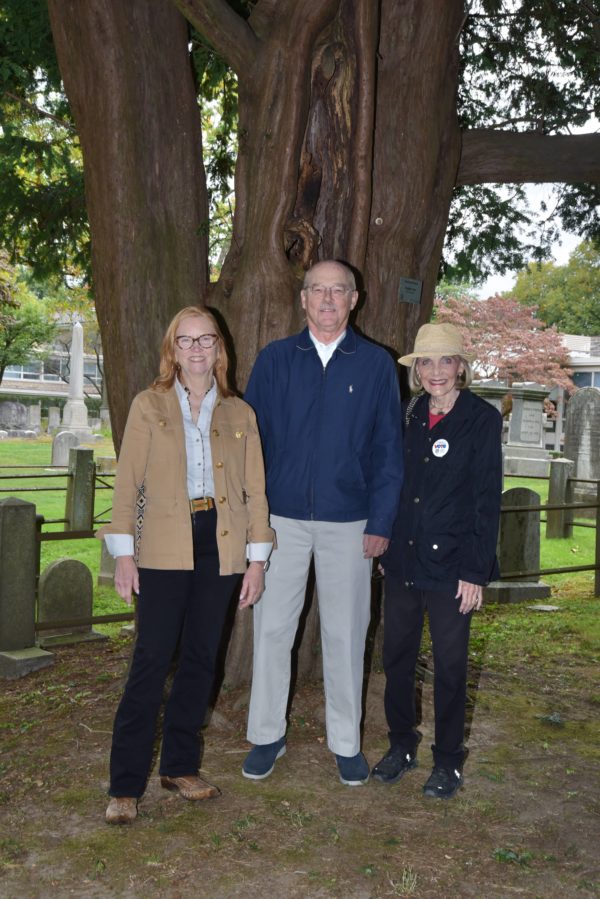
By Anne W. Semmes
Christ Church Greenwich has added another celebration to its 275th anniversary year – it’s English Yew Tree, dating back to “around 1800,” so chosen by the Greenwich Tree Conservancy (GTC) for its 2024 Treasured Tree, to be celebrated at its annual Treasured Trees event on October 24.
Note that this English Yew had earlier received a Certificate in 1989 as a Connecticut Notable Tree for being the largest known Yew in the state.”
This “massive and gnarly” Yew with a girth of 14-plus feet, and a height of 45-feet is located at the rear of the Christ Church cemetery, behind the Church. Its history is printed in Christ Church’s new history book “Celebrating Our History and Embracing Our Future” with a splendid photograph of the Yew tree. It reads: “In 1800 an English Yew was planted on the property that is now on the south side of Putnam Avenue…English Yews are not native to North America, and no one knows for sure how it came to grow on this Connecticut property.” Possibly, “a ship captain brought it as a seedling from the British Isles.”
It was with a fuller and fascinating history written in an application that parishioner and GTC supporter Rusty Parker and wife Katty nominated the Yew Tree for the 2024 GTC Treasured Tree contest. “They had nominated the tree in 2023 unsuccessfully,” told Bobbi Eggers, the Church’s director of marketing and communications. “But they were missing that fuller history of the tree that we now have.” Thus, Eggers urged the Parkers to renominate the Yew Tree for 2024.
Both Eggers and Rusty Parker were present on Monday for the official plaquing of the winning Treasured Yew Tree by the Tree Conservancy. The plaque reads: “English Yew” with its botanical name Taxus baccata. Also present was Church historian Lynn Garelick, Kate Dzikiewicz, GTC Executive Director, and Lisa Beebe, the Arboretum Project Curator for the GTC.
Parker told how the Yew tree came to his attention. “My mom died four years ago at age 98. And she’d always said that the graveyard needs help… at that time it had broken headstones and leaning headstones. So, some of her money went into an endowment account to help maintain the graveyard.” Parker would contact Church historian Lynn Garelick. “She’s the expert on the graveyard, and we had a great tour.” Garelick had pointed to the Yew tree as “this really old tree.” So, with his connections to the Tree Conservancy, “I put two and two together and tried to bring it to the surface.”
“It’s not particularly pretty,” Parker added. “It has sustained damage, but it’s still alive… And it’s amazing when things so old are alive. And it makes me think about what was the world like when that tree was planted? It just sits there, and it doesn’t require anything but a teeny bit of care. And it just continues. And of course, I’m a big fan of trees anyway, but this one, being so old and in a special place is just wonderful.”
For those interested in that fuller Yew tree history, it’s there in that successful application presented to the GTC including: “In the British Isles, yew trees are often found in cemeteries, which can provide unofficial protected status. The English Yew is one of the longest-lived tree species. One Yew in a Scottish cemetery is thought to be at least 2,000 years old; some say 5,000. But it is impossible to determine, as even if an ancient Yew tree is cut down, the interior of the trunk will often be hollowed out from age so rings can’t be accurately counted.”

And “If all goes well, this Yew tree should attain ‘ancient’ status when it is 500 years old, or in the year 2300.”
That Christ Church Yew Tree history continues: “Most Yews are either male or female, and our Yew appears to be male, as it never grows berries. In a felicitous pairing of death with life, the foliage of the Yew has been used for medicinal purposes by indigenous and ancient civilizations. In the late 1990s, it was discovered to contain a compound called paclitaxel, which makes up the cancer drug, Taxol, a very effective treatment for cancerous tumors, breast and ovarian cancer especially.”
And finally, “The Yew is not only an ornamental tree, but the wood has been used for timber and bow making, as it is tough yet flexible. It has been considered sacred not only by Christians but by many cultures for millennia, including ancient Greeks and Celts. While the Yew has spiritual significance, it is also considered a symbol of death, as the bark, leaves, and berry seeds of the Yew are poisonous to eat by humans (but not to touch, unlike the poison ivy that happily takes over any tree in reach).”
Lynn Garelick, as Christ Church historian and archivist, had shared her “gratefulness and delight” that the historic English Yew tree has been recognized and now carries a plaque commemorating its “majestic presence.”
She invited “all to visit the historic cemetery, stroll its grounds and stop and view this historic Yew tree that is now 224 years old.” And she thanked the Greenwich Tree Conservancy “for recognizing this beautiful tree and installing the lovely plaque.”
Appreciation for that fuller Yew history is attributed to the work of Christ Church participants Joanne Bouknight, Lynn Garelick, Emily Ragsdale, Karen Royce, Bobbi Eggers, and Rusty and Katty Parker.
For those interested in attending the Greenwich Tree Conservancy Treasured Trees Celebration, it is on Thursday, October 24 at 6:30 p.m. at Sam Bridge Nursery and Greenhouses. Tickets are available at https://greenwichtreeconservancy.org/treasured-trees-celebration/







